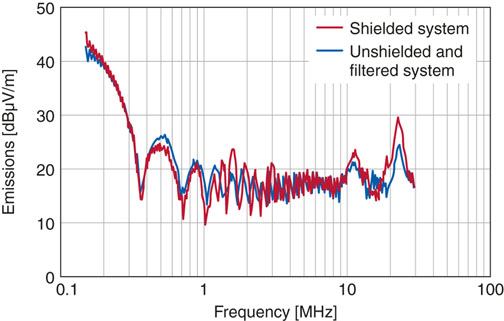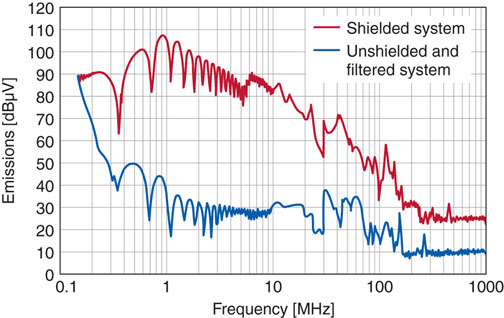As cars are equipped with more and more electronic systems, the probability of electromagnetic interference problems increase. This applies in particular to electric vehicles (xEVs) with their additional power electronics for the motor inverters. The use of EMC filters offers a reliable and weight-saving way to eliminate mutual interference from the densely packed sources.
Both hybrid and fully electric drive vehicles, or xEVs, are packed full of electronics which far exceed that of combustion-engined vehicles in both quantity and technical requirements. For, in addition to the increasingly complex systems for safety, comfort and communication, it is the electrical drive systems – the high-voltage battery, inverter, and at least one electric motor – that really up the ante the for the electronic systems. Consequently, the number one priority when developing such vehicles is to ensure that the individual systems, crammed into very restricted spaces, do not cause mutual interference. It is also important that no interference affects systems outside the vehicle. These EMC requirements are regulated by international standards such as CISPR 25 or the EU Directive ECE-R10.

Fig. 1: A battery and inverter system with cables between.
EMC problems caused by shielded cables
The inverters operate with pulse width modulation control of the motor. The steep edges of the pulses cause considerable EMC problems on both the input and output sides of the inverters, which manifest themselves as both radiated and conducted emissions. In order to keep these to a minimum, most conventional designs to date are based on a complete encapsulation or shielding.
To save space and improve the weight distribution, the individual drive components are distributed throughout the vehicle. The battery is usually accommodated at the rear and the inverter at the front. The motor or motors are installed on the axles or sometimes directly on the wheels. Connection of the inverter to the battery necessitates a long, shielded cable that entails significant potential risk for the EMC because, on the one hand, high shield currents can be generated that contribute to emissions in the high-frequency range. On the other hand, voltage spikes of sufficient magnitude can even damage the inverter or battery. Moreover, the possibility of interference being coupled into the low-voltage system of the vehicle cannot be ruled out.
The electrical and mechanical connection of the cable shielding to the shielding of the battery and inverter poses a further problem. The impedance of this connection must be extremely low in order to guarantee adequate shielding. But the vibrations and impacts inherent in vehicles create forces that weaken the shielding connection, causing a gradual long-term rise in impedance. Aging processes caused by oxidation, or even corrosion, are not insignificant either.
The radiated and conducted emissions of a system with shielded cable between the battery and inverter are depicted in Figure 2.


Fig. 2: The use of a shielded cable between battery and inverter reduces the radiated emissions (above), it does not reduce the conducted emissions (below).
Clear improvement in EMC through use of filters
A superior approach to coping with the growing demands made on EMC design involves the use of high-voltage DC filters. To be suitable for electric vehicles they need to be designed for a maximum voltage of 600 V DC, corresponding to the typical voltages of high-voltage batteries. To enable the filtering of drive systems with power ratings considerably in excess of 100 kW, their current capabilities should cover the range of up to around 150 A DC or 350 A DC. The EMC filters must offer a very low DC resistance to avoid significant losses.
As shown in Figure 3, it was possible to confirm the improved EMC performance when an EMC filter was used in the test setup.


Fig. 3: An EMC filter between battery and inverter results in a dramatic reduction in the conducted interference, in particular.
Despite using an unshielded cable, the conducted interference in particular could be reduced by up to 70 dB, or a factor of 3,000. Furthermore, the use of the EMC filters enable a considerable reduction in the number of conventional EMC measures in the individual system components. Eliminating the need for shielded cables, for example, helps to save on weight and space.
Two-wire high-voltage DC filters for EMC are available from a number of manufactures. Take a look at http://en.tdk.eu/tdk-en/530186/products/product-catalog/emc-components for EMC components from TDK and Epcos.
Advertisement
Learn more about EPCOSTDK-EPC





